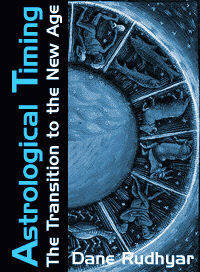 |
| Home | Bio | Art | Music | Literature | Civilization & Culture | Philosophy of Wholeness | Theosophy & Spirituality | Astrology |

ASTROLOGICAL TIMING
The Transition to the New Age by Dane Rudhyar, 1969 First published under the title Birth Patterns for a New Humanity
CONTENTS
PROLOGUE Where Do We Stand Today? PART ONE 1. Three Centuries of Crisis 2. Planetary Cycles 3. Cycles of Relationship PART TWO 4. Stars, Constellations and Signs of the Zodiac 5. From Buddha to Christ 6. The Structure of the Piscean Age 7. At the Gates of the New Age 8. The Aquarius-Leo Age Page 1 Page 2 The Pisces-Virgo Age Page 3 Page 4 The Aquarian Fecundation Page 5 The Age of Management of Power Page 6 Page 7 The Orientation of Consciousness Page 8 Page 9 PART THREE 9. The Zodiacal Earth-Field 10. As We Face the Future EPILOGUE |

CHAPTER EIGHT
The Aquarius-Leo Age - 2 The equinoxes may be considered as two "gates." At the vernal gate spirit enters into humanity and impregnates responsive human minds with great ideas, new rhythmic impulses, new "symbols of power." At the autumnal gate, individuals who have assimilated into their consciousness these creative gifts of the spirit and emerged from the womb of undifferentiated "human nature," rise, as individuals, to the divine Source and, in full consciousness, teach and embody into forms of understanding and of social relationship the Vision which "God" has bestowed upon them. As I wrote many years ago, "the march of civilization is the march of earth-nature toward God — through Man." But the positive factor in this onward march is the creative power of the spirit acting through ideas and impulses which thrill and fecundate humanity, causing great personages, who are mouthpieces of divinity and Fathers of civilization, to establish the foundations of new cultures in new or revitalized lands. Because this positive factor is represented by the vernal polarity of the equinoctial axis, it has been customary to speak, for instance, of the "Taurean" or "Piscean" Ages. Yet, I repeat, such a practice is obviously inadequate; it restricts our understanding of what is really at stake, and particularly of the operation of cultural forces throughout a whole equinoctial Age. Indeed, by focusing the attention of the mind using the astrological tool of the equinoctial cycle upon the spiritually creative factor alone — which is not productive of strictly speaking "cultural" manifestations — a great deal of confusion has been caused as to what constitutes the "beginning" of an Age. When the historian Oswald Spengler claimed that our Christian-European culture "began" around 900 AD with the spread of the Romanesque style and the birth of the great myths and legends which inspired poets and artists of subsequent centuries, he was right within the narrow limits of his understanding of the term "culture." Spengler, however, failed to grasp the meaning of the creative Impulse — the "Christ Impulse" — which is at the root of the Christian-European culture, because his absolute glorification of what he called "culture" made him blind to the positive meaning of "civilization." In its spiritual meaning, civilization refers to the universalistic creative Impulse of the spirit, and culture to the ascent of man (limited by particular earth conditions) toward God. By permission of Leyla Rudhyar Hill Copyright © 1969 by Dane Rudhyar and Copyright © 2001 by Leyla Rudhyar Hill All Rights Reserved.  Web design and all data, text and graphics appearing on this site are protected by US and International Copyright and are not to be reproduced, distributed, circulated, offered for sale, or given away, in any form, by any means, electronic or conventional. See Notices for full copyright statement and conditions of use. Web design copyright © 2000-2004 by Michael R. Meyer. All Rights Reserved. |
 |